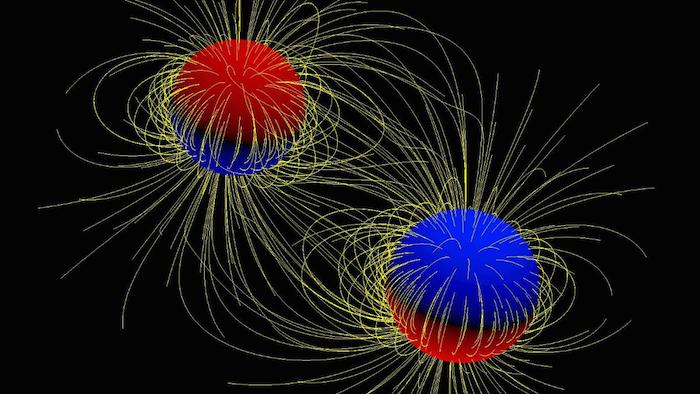.

The polarity of the star's surface magnetic field, north or south, is indicated by red and blue respectively. Yellow lines indicate the magnetic field lines running from the stellar surfaces. Credit: Visualisation courtesy of Volkmar Holzwarth, KIS, Freiburg
.
PhD candidate Matt Shultz discovers massive binary star with unique properties.
PhD candidate Matt Shultz has discovered the first massive binary star, epsilon Lupi, in which both stars have magnetic fields. A binary star is a star system consisting of two or more stars, orbiting around their common centre of mass.
For the past few years, the BinaMIcS (Binarity and Magnetic Interactions in various classes of Stars) collaboration, formed to study the magnetic properties of close binaries, has been trying to find such an object. They have now discovered one using the Canada-France-Hawaii Telescope.
“The origin of magnetism amongst massive stars is something of a mystery,” says Mr. Shultz (Physics, Engineering Physics and Astronomy), “and this discovery may help to shed some light on the question of why these stars have magnetic fields.”
In cool stars, such as the Sun, magnetic fields are generated by a convection in the outer portion of the star. However, there is no convection in the outer layers of massive star, so there is no support for a magnetic dynamo. Nevertheless, approximately 10 per cent of massive stars have strong magnetic fields.
Two explanations have been proposed for the origin of massive star magnetic fields, both variants on the idea of a so-called “fossil” magnetic field, which is generated at some point in the star's past and then locked in to the star's outer portion.
The first hypothesis is that the magnetic field is generated while the star is being formed; the second is that the magnetic field originates in dynamos driven by the violent mixing of stellar plasma when the two stars in a close binary merge.
“This discovery doesn't change the basic statistics that the BinaMIcS collaboration has assembled,” says Mr. Shultz, “and we still don't know why there are so few magnetic, massive stars in close binaries.”
The research shows the strengths of the magnetic fields are similar in the two stars, however, their magnetic axes are anti-aligned, with the south pole of one star pointing in approximately the same direction as the north pole of the other.
“We're not sure why that is yet, but it probably points to something significant about how the stars are interacting with one another. We’ll need to collect more data.”
The research was published in the Monthly Notices of the Royal Astronomical Society.
Quelle: Queen's University
4042 Views
